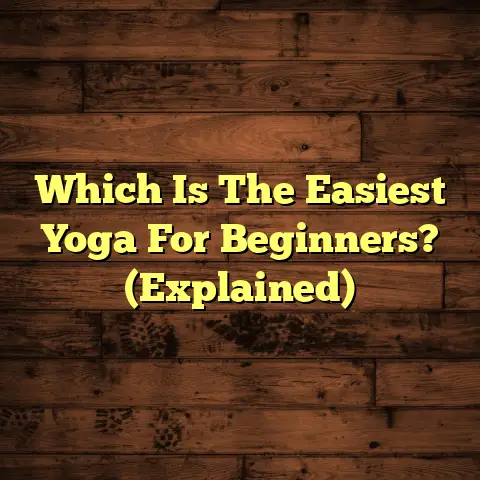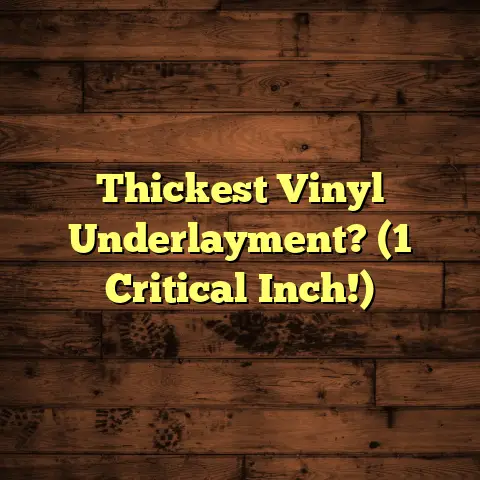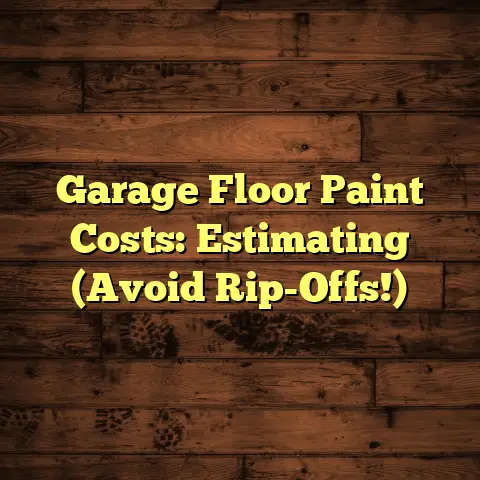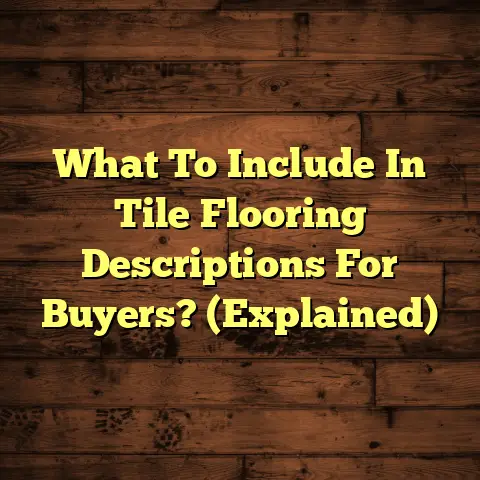Cleaning Luxury Vinyl Planks? (3 Pro Cleaning Tips!)
LVP has exploded in popularity, and for good reason. It’s durable, looks fantastic, and doesn’t break the bank. Plus, it’s easier to maintain than, say, hardwood.
But even with its reputation for easy care, LVP can still present some cleaning challenges. Sticky residue? Scuff marks from the kids’ toys?
Don’t sweat it. A quick fix I often recommend to my clients is a simple mix of warm water and a few drops of gentle dish soap. It works wonders on surface dirt and grime.
But that’s just the tip of the iceberg. Let’s dive into the world of LVP cleaning and get those floors sparkling!
Understanding Luxury Vinyl Planks (LVP)
So, what exactly is LVP? Simply put, it’s a multi-layered synthetic flooring product designed to mimic the look of natural materials like wood or stone.
Unlike traditional vinyl, LVP is thicker and more rigid, giving it a more substantial feel underfoot. It’s usually made of four layers:
- Wear Layer: This is the top layer that protects the floor from scratches, stains, and wear.
- Print Layer: This layer gives the LVP its realistic appearance.
- Core Layer: This provides stability and waterproofness.
- Backing Layer: This adds cushioning and helps prevent the floor from slipping.
One of the biggest benefits of LVP is its water resistance. Unlike hardwood, it can handle spills and moisture without warping or buckling. That makes it a great choice for kitchens, bathrooms, and basements.
We’ve installed LVP in countless homes and businesses, and clients love it. According to recent industry reports, the LVP market is projected to continue growing at a rapid pace, with some estimates predicting a double-digit growth rate over the next five years.
Why? Because it offers a winning combination of affordability, durability, and style.
Now, let’s bust some common myths about LVP cleaning:
- Myth #1: You can use any cleaner on LVP. Nope! Harsh chemicals can damage the wear layer.
- Myth #2: LVP is completely scratch-proof. Not true. While it’s durable, it can still scratch, especially from sharp objects or abrasive cleaners.
- Myth #3: You don’t need to clean LVP often. Wrong again! Regular cleaning is essential to prevent dirt and grime from building up and dulling the finish.
Pro Cleaning Tip #1: The Right Cleaning Solutions
Choosing the right cleaning solution is crucial for maintaining the beauty and longevity of your LVP floors. Using the wrong product can lead to damage, discoloration, and a dull, lifeless appearance.
Think of it like this: you wouldn’t use sandpaper to wash your car, right? Same principle applies here.
So, what should you use? Here’s a breakdown of recommended cleaning solutions, including both commercial and DIY options:
Commercial Cleaning Solutions:
- pH-Neutral Cleaners: These are specifically formulated for LVP and are gentle enough to use regularly. Look for products that are labeled as “pH-neutral” or “safe for vinyl floors.”
- Specialized LVP Cleaners: Many manufacturers offer their own branded cleaners that are designed to work perfectly with their LVP products. These can be a good option, but they tend to be more expensive.
- Enzyme Cleaners: Great for pet owners! Enzyme cleaners break down organic matter like urine and feces, eliminating odors and preventing stains.
DIY Cleaning Solutions:
- Warm Water and Dish Soap: As I mentioned earlier, this is a simple but effective solution for general cleaning. Use a mild dish soap and only a few drops per gallon of water. Too much soap can leave a residue.
- Vinegar and Water: A classic cleaning solution! Mix one cup of white vinegar with one gallon of warm water. Vinegar is a natural disinfectant and helps to remove dirt and grime.
- Baking Soda Paste: For stubborn stains, make a paste of baking soda and water. Apply it to the stain, let it sit for a few minutes, and then gently scrub with a soft cloth.
What to Avoid:
- Abrasive Cleaners: These include scouring powders, steel wool, and abrasive scrub pads. They can scratch and dull the finish of your LVP.
- Solvent-Based Cleaners: Avoid using solvents like acetone, nail polish remover, or paint thinner. These can damage the vinyl and cause discoloration.
- “Mop and Shine” Products: These products often leave a waxy buildup on LVP, making it look dull and attracting dirt.
- Steam Mops: While some manufacturers say steam mops are okay, I generally advise against them. The heat can potentially damage the adhesive or cause the planks to warp over time.
Step-by-Step Guide:
- Gather Your Supplies: You’ll need your chosen cleaning solution, a bucket, a microfiber mop, and a vacuum cleaner or broom.
- Prepare the Cleaning Solution: Follow the instructions on the cleaning product label, or mix your DIY solution according to the recipes above.
- Test in an Inconspicuous Area: Before cleaning the entire floor, test the solution in a small, hidden area to make sure it doesn’t damage or discolor the LVP.
- Vacuum or Sweep: Remove any loose dirt, dust, or debris from the floor.
- Mop the Floor: Dip the microfiber mop into the cleaning solution and wring it out thoroughly. You want the mop to be damp, not soaking wet. Mop the floor in overlapping strokes, making sure to cover the entire surface.
- Rinse (Optional): If you’re using a soap-based cleaner, you may want to rinse the floor with clean water to remove any residue.
- Dry the Floor: Use a clean, dry microfiber cloth to dry the floor thoroughly. This will help prevent water spots and streaks.
Pro Cleaning Tip #2: The Best Cleaning Tools
Having the right tools can make all the difference in how effectively you clean your LVP floors. Using the wrong tools can not only make the job harder but can also damage your floors.
Here’s a rundown of the essential tools for cleaning LVP:
- Microfiber Mop: A microfiber mop is a must-have for cleaning LVP. Microfiber is super absorbent and gentle on surfaces, making it perfect for removing dirt and grime without scratching the floor. Look for a mop with a swivel head for easy maneuverability.
- Vacuum Cleaner with Soft Brush Attachment: Vacuuming is an essential part of LVP maintenance. A vacuum cleaner with a soft brush attachment will remove loose dirt, dust, and debris without scratching the floor. Avoid using vacuums with beater bars, as they can damage the LVP.
- Non-Abrasive Scrub Pads: For stubborn stains and scuff marks, a non-abrasive scrub pad can be your best friend. Look for pads that are specifically designed for use on vinyl floors. Test in an inconspicuous area first!
- Soft Cloths: Soft cloths, like microfiber cloths, are great for wiping up spills, drying the floor after mopping, and applying cleaning solutions.
- Spray Bottle: A spray bottle is handy for applying cleaning solutions to small areas or for spot cleaning.
Benefits of Each Tool:
- Microfiber Mop: The microfiber mop is gentle on the floor, picks up dirt and grime effectively, and is easy to maneuver.
- Vacuum Cleaner with Soft Brush: The vacuum cleaner removes loose debris quickly and efficiently, preventing it from being ground into the floor.
- Non-Abrasive Scrub Pad: The scrub pad helps to loosen stubborn stains and scuff marks without damaging the LVP.
- Soft Cloths: Soft cloths are versatile and can be used for a variety of cleaning tasks.
- Spray Bottle: The spray bottle allows for targeted application of cleaning solutions.
Tips for Using These Tools Effectively:
- Mopping:
- Always wring out the mop thoroughly before mopping the floor. A wet mop can leave streaks and water spots.
- Mop in overlapping strokes to ensure that you cover the entire surface.
- Rinse the mop frequently to remove dirt and grime.
- Dry the floor with a clean, dry cloth after mopping.
- Vacuuming:
- Use the soft brush attachment to avoid scratching the floor.
- Vacuum in overlapping strokes to ensure that you pick up all the loose debris.
- Empty the vacuum cleaner bag or canister regularly to maintain suction.
- Scrubbing:
- Use a light touch when scrubbing. Applying too much pressure can damage the LVP.
- Test the scrub pad in an inconspicuous area before using it on the entire floor.
- Rinse the area thoroughly after scrubbing to remove any residue.
Pro Cleaning Tip #3: Preventive Care and Maintenance
Preventive care is the unsung hero of LVP maintenance. It’s like flossing your teeth – a little effort regularly can save you from big problems down the road.
Regular maintenance not only keeps your LVP looking its best but also prolongs its lifespan. By taking a few simple precautions, you can minimize dirt accumulation, prevent damage, and keep your floors looking beautiful for years to come.
Here are some key preventive measures:
- Use Mats at Entryways: Place mats at all entryways to trap dirt, dust, and moisture before they get tracked onto your LVP floors. Choose mats that are made of non-staining materials and have a non-slip backing.
- Implement a No-Shoes Policy: Encourage family members and guests to remove their shoes before entering your home. Shoes can track in dirt, gravel, and other debris that can scratch and damage LVP.
- Use Furniture Pads: Place felt pads under the legs of furniture to prevent scratches and dents. Replace the pads regularly as they wear down.
- Trim Pet Nails: Keep your pet’s nails trimmed to prevent them from scratching the LVP.
- Clean Up Spills Immediately: Wipe up spills as soon as they happen to prevent staining and damage.
- Avoid Dragging Heavy Objects: When moving furniture or heavy objects, use furniture sliders or dollies to protect the LVP from scratches and dents.
Maintenance Schedule:
Here’s a sample maintenance schedule to help you keep your LVP looking its best:
- Daily:
- Sweep or vacuum the floor to remove loose dirt and debris.
- Wipe up spills immediately.
- Weekly:
- Mop the floor with a pH-neutral cleaner or a DIY solution of warm water and dish soap.
- Monthly:
- Inspect the floor for stains, scuff marks, and other issues.
- Spot clean any problem areas with a non-abrasive scrub pad and a gentle cleaning solution.
- As Needed:
- Deep clean the floor with a specialized LVP cleaner or a vinegar and water solution.
- Repair any scratches or dents.
By following this maintenance schedule and taking the preventive measures outlined above, you can keep your LVP floors looking beautiful and pristine for years to come.
Addressing Common Stains and Issues
Even with the best care, your LVP floors are bound to encounter some stains and issues over time. Knowing how to address these problems quickly and effectively can help prevent permanent damage and keep your floors looking their best.
Here’s a guide to tackling common stains and issues:
Common Stains:
- Food and Drink Spills: Wipe up spills immediately with a clean cloth. For stubborn stains, use a solution of warm water and dish soap or a specialized LVP cleaner.
- Pet Accidents: Clean up pet accidents as soon as possible to prevent staining and odor. Use an enzyme cleaner to break down the organic matter and eliminate odors.
- Grease and Oil: Absorb excess grease or oil with a paper towel. Then, clean the area with a solution of warm water and dish soap.
- Ink: Blot the ink stain with a clean cloth. Then, apply rubbing alcohol to the stain and blot again. Repeat until the stain is gone.
- Adhesive Residue: Remove adhesive residue with a plastic scraper or a soft cloth dampened with mineral spirits. Be sure to test the mineral spirits in an inconspicuous area first.
Troubleshooting Tips:
- Scratches: For minor scratches, try using a scratch repair kit specifically designed for vinyl floors. For deeper scratches, you may need to replace the damaged plank.
- Dents: Place a damp cloth over the dent and iron it with a warm iron. The heat and moisture may help to raise the dent. If that doesn’t work, you may need to replace the damaged plank.
- Discoloration: Discoloration can be caused by sunlight, harsh chemicals, or certain types of mats. To prevent discoloration, use window coverings to block sunlight, avoid using harsh chemicals, and choose mats that are made of non-staining materials.
- Loose Planks: If a plank comes loose, you can try to re-adhere it with vinyl flooring adhesive. If that doesn’t work, you may need to replace the plank.
- Squeaking Floors: Squeaking floors can be caused by loose planks or subfloor issues. To fix squeaking floors, you may need to add shims under the loose planks or repair the subfloor.
When to Consult a Professional:
While many LVP issues can be resolved with DIY methods, there are times when it’s best to consult with a professional flooring contractor. Here are some situations where professional help is recommended:
- Extensive Damage: If your LVP floors have extensive damage, such as widespread scratches, dents, or discoloration, it may be more cost-effective to replace the entire floor.
- Subfloor Issues: If you suspect that there are issues with the subfloor, such as moisture damage or unevenness, it’s important to have a professional inspect the area and make the necessary repairs.
- Complex Repairs: If you’re not comfortable performing complex repairs, such as replacing multiple planks or repairing squeaking floors, it’s best to leave the job to a professional.
Conclusion
Luxury Vinyl Planks are a fantastic flooring option, offering a blend of beauty, durability, and affordability. But like any flooring, they require proper care and maintenance to keep them looking their best.
Remember those three pro tips?
- Use the right cleaning solutions: Avoid harsh chemicals and abrasive cleaners. Opt for pH-neutral cleaners or DIY solutions like warm water and dish soap or vinegar and water.
- Use the best cleaning tools: Invest in a microfiber mop, a vacuum cleaner with a soft brush attachment, and non-abrasive scrub pads.
- Practice preventive care: Use mats at entryways, implement a no-shoes policy, and clean up spills immediately.
By following these tips, you can keep your LVP floors looking clean, beautiful, and pristine for years to come. Now go forth and conquer those floors!





